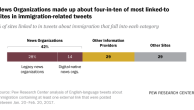In addition to the analysis of the media coverage of the early days of the Biden administration, this project for the first time includes a survey component in order to study Americans’ sense of the news coverage of the new administration based on their different media diets.
To do this, the survey, conducted March 8-14, 2021, asked respondents to indicate whether they got political news in the past week from each of 25 national news outlets (see Appendix A for details). These are the same outlets included in the content analysis study.1
Roadmap to Part 2 of this report

Part 2 of this study examines Americans’ views and perceptions of the coverage of the early days of the administration. Here, Americans are grouped according to the audience makeup of the outlets that they turned to for political news in the past week. The study focuses on six groups in this section, based on the 25 outlets asked about: those whose media diets are only on the right, those whose media diets tend toward the right, those whose media diets are neither on the left nor the right, those whose media diets tend toward the left, and those whose media diets are only on the left. Categorizing Americans by their media diet in this way can show how views of news coverage and current events can be connected to one’s news choices (see Appendix A for more detail).
Respondents were then grouped into six groups based on the audience makeup of the outlets they turn to for political news. These outlets are classified in the content study as having a left-leaning, right-leaning or mixed audience.
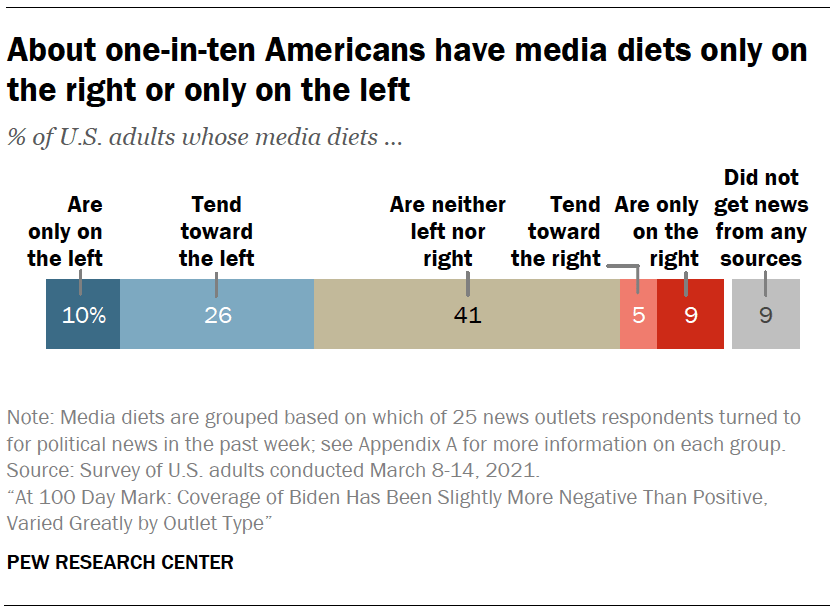
The largest segment of U.S. adults (41%) have media diets that are neither on the left nor on the right – they might turn to outlets with left-leaning and right-leaning audiences at roughly similar rates, or they might turn more toward outlets with mixed audiences. The next largest group (26%) includes those who have media diets that tend toward the left but include some outlets with right-leaning and/or mixed audiences as well. One-in-ten adults turn only to outlets with left-leaning audiences, 9% look only to outlets with right-leaning audiences, and 5% tend to go to outlets with audiences that lean to the right.2
Additionally, 9% of respondents did not get political news in the past week from any of the 25 outlets asked about. This group is less likely to follow news about a variety of topics and is not included in most of the analysis in this report.
The demographic makeup of these media diet groups varies.
Looking at the groups by party identification, almost one-in-five Republicans and those who lean toward the GOP (19%) have media diets that are only on the right (vs. 1% of Democrats and Democratic leaners), and Democrats are more likely than Republicans to have media diets only on the left (15% vs. 4%). Another large portion of Democrats (41%) have media diets that tend toward the left, compared with 9% of Republicans.
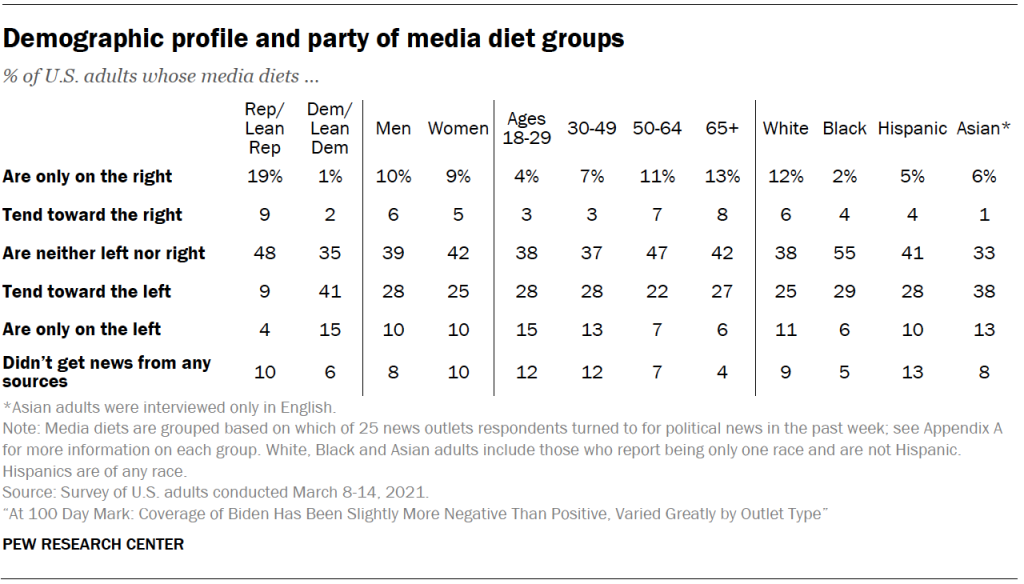
But substantial portions of those who identify with or lean toward each party – including nearly half of Republicans (48%) and about a third of Democrats (35%) – have media diets that do not tend to the left or the right.
Aside from party identification, younger Americans are more likely than those older than them to have a media diet that is only on the left, while older Americans are more likely to have a media diet only on the right. And White adults are more likely than Black adults to turn to news outlets with exclusively right-leaning or left-leaning audiences, while Black adults are more inclined toward a more mixed news diet.
Most U.S. adults paying at least fairly close attention to Biden administration actions
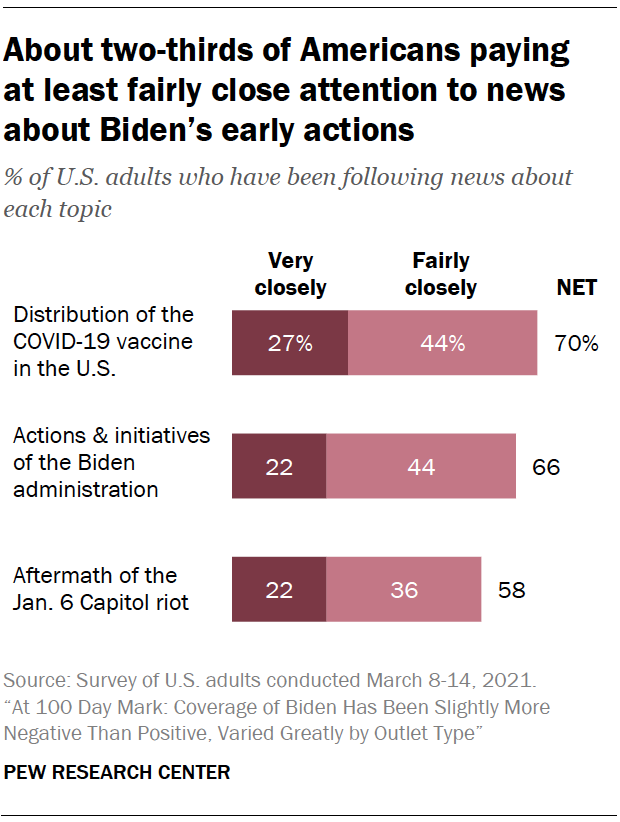
Overall, a majority of Americans have paid attention to news about the Biden administration as well as to two other major storylines in the news.
About one-in-five U.S. adults (22%) said at the time of the survey that they had been following news about the Biden administration very closely, with another 44% following it fairly closely. Meanwhile, 27% of Americans had been following news about the COVID-19 vaccine distribution very closely (another 44% were following fairly closely), and 22% said they were following news about the aftermath of the Jan. 6 Capitol riot very closely (with 36% following fairly closely).
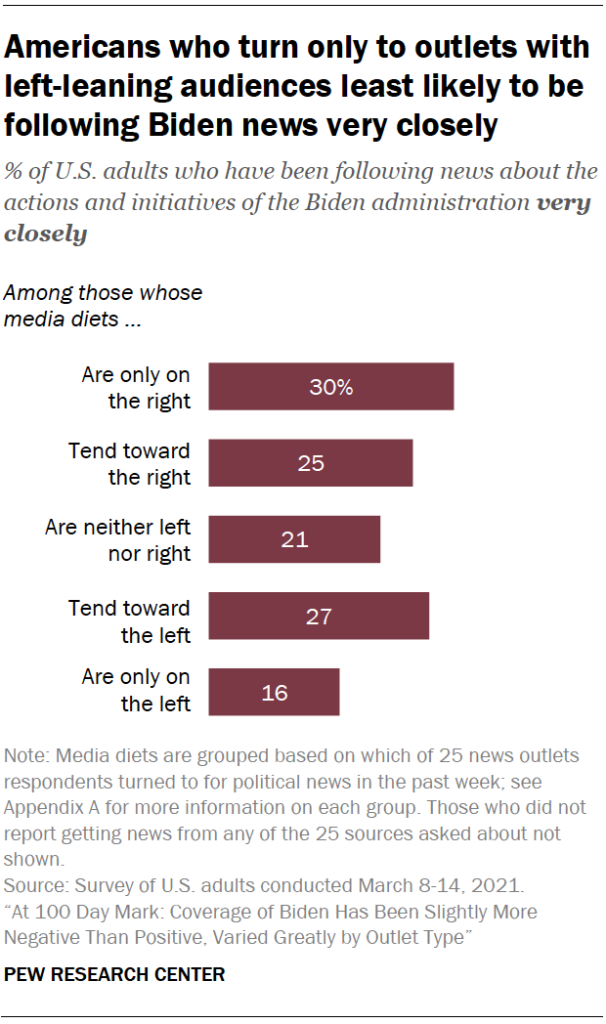
There is some difference in attention to the Biden administration’s actions across media diet groups. Three-in-ten Americans whose news diet is exclusively on the right said they had been following the actions and initiatives of the Biden White House very closely, nearly double the 16% following the administration very closely in the group that gets news only from sources with left-leaning audiences. Individuals with a more mixed news diet were about in the middle, with 21% following the Biden administration’s actions very closely.
Americans’ awareness of news about specific initiatives of the Biden administration varies
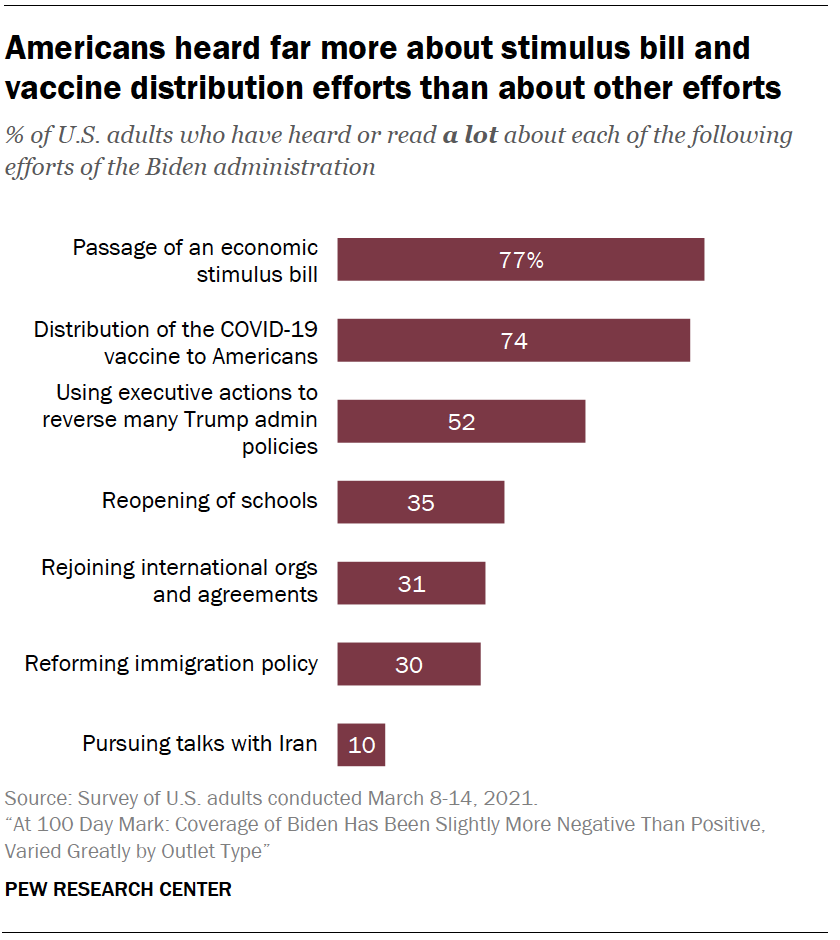
A number of key events related to the new Biden administration occurred in the weeks leading up to and during the March 8-14 survey period. These included the following:
- Biden signed the $1.9 trillion stimulus package on March 11, after it made its way through both houses of Congress.
- Vaccine distribution was quickly ramping up, and by the first week in March, the nation was averaging 2 million doses a day. On March 11, Biden gave his first prime-time address on vaccine distribution.
- In December, Biden announced a goal of opening most K-12 schools in the first 100 days of his presidency.
- As the number of migrants, particularly children, built up at the southern border, media coverage intensified. House Speaker Nancy Pelosi described the situation as a “humanitarian crisis” on March 14.
- The Biden administration used executive actions to reverse a number of policies put into place by the Trump administration.
Of seven specific efforts presented in the survey, the passage of the economic stimulus bill and the distribution of the COVID-19 vaccine topped the list as the ones that were gaining the most attention. Nearly eight-in-ten U.S. adults (77%) said they had heard a lot about the stimulus package, while 74% had heard a lot about vaccine distribution. Roughly half of U.S. adults (52%) said they have heard a lot about Biden’s use of executive actions to reverse many Trump administration policies. Fewer had heard a lot about the reopening of schools (35%), rejoining international organizations and agreements (31%) or the reforming of immigration policy (30%), and just 10% said they had heard a lot about pursuing talks with Iran.
Media diet groups differed substantially in how much they had heard about these topic areas. Those in the group with a right-only media diet were most likely to say they had heard a lot about Biden’s use of executive actions (79%), nearly twice the share as those who turn only to outlets with left-leaning audiences (42%). This group with a right-only media diet also was about twice as likely as the group with a left-only media diet to have heard a lot about immigration reform efforts (45% vs. 21%).
The one storyline the groups with media diets on the left or tending left had heard considerably more about than the right-only and tend-right groups was vaccine distribution. Three-quarters of those who turn only to outlets with left-leaning audiences had heard a lot about the vaccine rollout, as had 85% of those whose media diet tends toward the left. That compares with 59% of the group with a right-only media diet and 64% of the group whose media diet tends toward the right.
Awareness of news about the economic stimulus bill was more consistent across groups. About three-quarters (73%) or more of all five media diet groups said they had heard a lot about the stimulus bill.
The two topics most Americans were most likely to have heard a lot about are largely in line with the analysis of coverage in Part I, where the economy and health care were the two leading topics covered during the period studied.
Further, the differences based on media diet in what Americans hear a lot about in some cases reflects more coverage from outlets with left- or right-leaning audiences. The topic of immigration, for example, was more likely to be covered by outlets with right-leaning audiences, and Americans who got political news exclusively from those outlets in this survey were about twice as likely to have heard a lot about the efforts to reform immigration policy than those turning only to outlets with left-leaning audiences (45% vs. 21%). The topic of health care, on the other hand, was covered at a higher rate by outlets with left-leaning audiences, and Americans with media diets only on the left or tending toward the left were more likely to have heard a lot about the COVID-19 vaccine distribution than those with only-right and tend-right media diets.
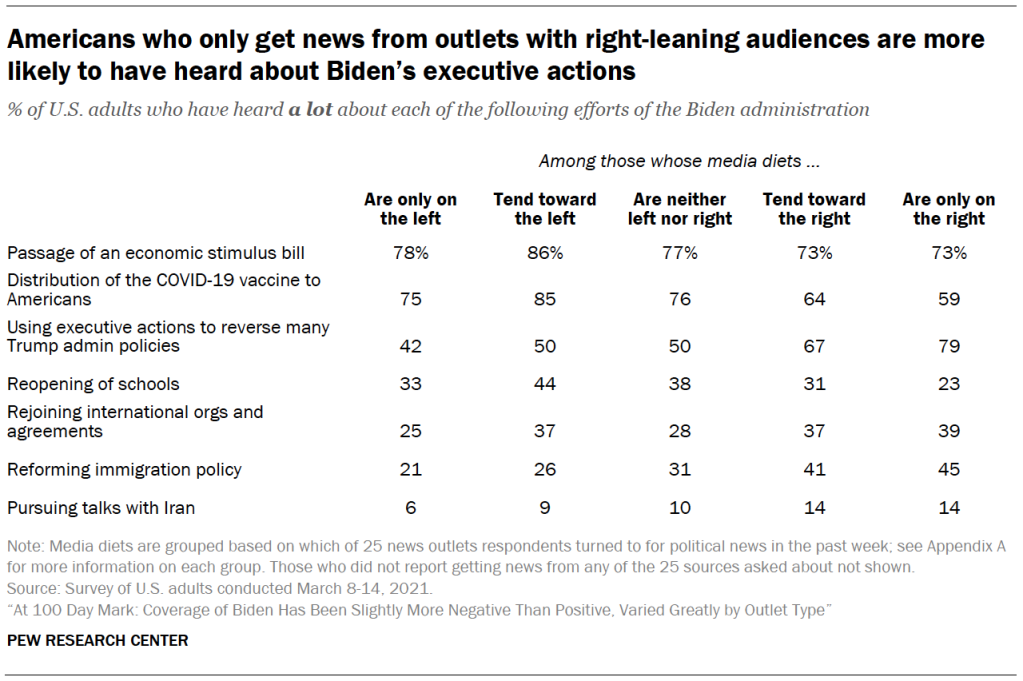
Across media diets, Americans report seeing far more news related to Biden’s policy agenda than character
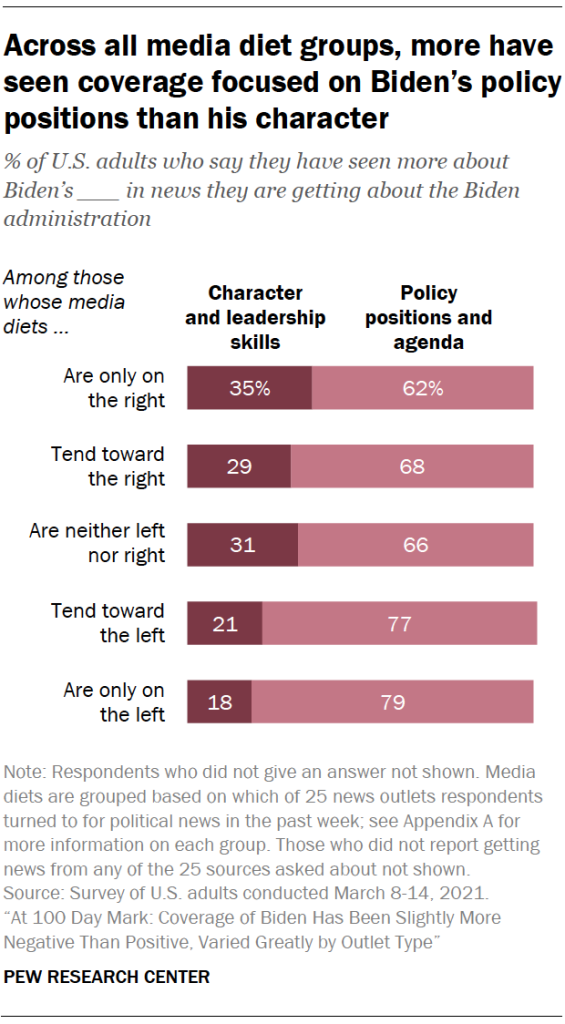
Roughly seven-in-ten Americans overall (69%) said in the March survey they had been seeing more news related to Biden’s policy positions and agenda than to his character and leadership skills.
This is an area of broad consistency across those with varying media diets. Americans who turn only to or tend to get news from outlets with left-leaning audiences were the most likely to say they had seen more news about Biden’s policy positions (79% and 77%, respectively). Still, a majority of those who consume news only from sources with right-leaning audiences (62%) said the same.
These responses are also in line with the findings from the study of news coverage in Part I, which showed a heavier focus on Biden and his administration’s policy and agenda than on character and leadership skills, including a majority of stories from outlets with left-leaning audiences, right-leaning audiences and mixed audiences.



